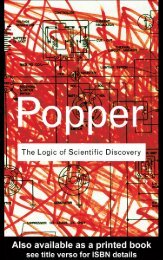You also want an ePaper? Increase the reach of your titles
YUMPU automatically turns print PDFs into web optimized ePapers that Google loves.
HOW PEIRCEAN WAS THE “‘FREGEAN’ REVOLUTION” IN LOGIC? 23<br />
Thus, as we see, Tarski credited Peirce with the invention of the calculus of binary relations. Although we<br />
might trace the bare beginnings to De Morgan, and in particular to the fourth installment of his On the Syllogism” [De<br />
Morgan 1860], Tarski [1941, 73] held that De Morgan nevertheless “cannot be regarded as the creator of the modern<br />
theory of relations, since he did not possess an adequate apparatus for treating the subject in which he was interested,<br />
and was apparently unable to create such an apparatus. His investigations on relations show a lack of clarity and rigor<br />
which perhaps accounts for the neglect into which they fell in the following years. The title of creator of the theory of<br />
relations was reserved for.” In any case, it was, as Vaughn Pratt [1992] correctly noted, Peirce who, taking up the subject<br />
directly from De Morgan in “Description of a Notation for the Logic of Relatives…” [Peirce 1870], brought to<br />
light the full power of that calculus, by articulating those technicalities at which De Morgan’s work only hinted. More<br />
to the point for our purposes, and in contradistinction to the judgment of van Heijenoort on behalf of the “Fregeans”<br />
against the “Booleans”, Pratt [1992, 248; my emphasis] stresses the point, among others, that: “The calculus of binary<br />
relations as we understand it today…is a logic.”<br />
The algebraic logic and logic of relations with which we are familiar today is the work largely of Tarski and his<br />
students, initiated by Tarski in picking up where Peirce and Schröder left off. Major results established by Tarski and<br />
his student Steven Givant in their A Formalization of Set Theory without Variables [Tarski & Givant 1987] was to<br />
answer a question posed by Schröder and answered, in the negative by Alwin Reinhold Korselt (1864–1947) (but reported<br />
on Korselt’s behalf by Löwenheim [1914, 448], as to whether every formula of binary first-order quantificational<br />
logic is reducible (expressible) in the Peirce-Schröder calculus, as stated in the Korselt-Tarski Theorem; a generalization,<br />
which asserts that set theory cannot be formulated within a theory having three two-place predicate constants<br />
of the second type and four two-place function constants of the third type, or any extensions of such a language;<br />
and the special, closely related result, the so-called Main Mapping Theorem, asserting that there is a formula of firstorder<br />
quantification theory having four constants, which cannot be expressed in the three-constant theory or any of its<br />
extensions, thus—apparently—specifically contradicting Peirce’s Reduction Thesis, that every equation of the logic of<br />
relations in which there is a quaternary relation can be expressed by an equation composed of a combination of monadic,<br />
dyadic, and triadic relations, by exhibiting an equation having four or more terms is reducible to an expression<br />
comprised of some combination of statements of one, two, and three terms (see [Anellis 1997]; see [Anellis & Houser<br />
1991], [Maddux 1991] and [Moore 1992] for general historical background).<br />
For the role that Peirce’s formulation of quantifier theory played in the work of Schröder and the algebraic logicians<br />
who followed him, as well as the impact which it had more widely, not only on Löwenheim, Skolem, and<br />
Herbrand, Hilary Putnam [1982, 297] therefore remarked that: “Frege did “discover” the quantifier in the sense of having<br />
the rightful claim to priority. But Peirce and his students discovered it in the effective sense.”<br />
4. Peirce’s definitions of infinite sequence and natural number in terms of logical notions (i.e. the logicization of mathematics):<br />
Frege developed his theory of sequences, defined in terms of logical notions in the third and final part of the<br />
Begriffsschrift [1879, Th. III, §§23-31], giving us first the ancestral relation and then the proper ancestral, the latter<br />
required in order to guarantee that the sequences arrived at are well-ordered. With the ancestral proper, he is finally<br />
able to define mathematical induction as well.<br />
In his “The Logic of Number” [Peirce 1881] of 1881, Peirce set forth an axiomatization of number theory, starting<br />
from his definition of finite set to obtain natural numbers. Given a set N and R a relation on N, with 1 an element of N;<br />
with definitions of minimum, maximum, and predecessor with respect to R and N given, Peirce’s axioms, in modern<br />
terminology, are:<br />
1. N is partially ordered by R.<br />
2. N is connected by R.<br />
3. N is closed with respect to predecessors.<br />
4. 1 is the minimum element in N; N has no maximum.<br />
5. Mathematical induction holds for N.<br />
It is in this context important to consider Sluga’s testimony [Sluga 1980, 96–128], that it took five years beyond<br />
the completion date of December 18, 1878 for the Begriffsschrift to provide the promised elucidation of the concept of<br />
number following his recognition that are logical objects and realizing that he had not successfully incorporated that<br />
recognition into the Begriffsschrift [Frege 1879]. Certainly, if Peirce in 1881 had not yet developed a complete and<br />
coherent logical theory of number, neither, then, had Frege before 1884 in the Die Grundlagen der Arithmetik [Frege





